Time ball
A time ball or timeball is an obsolete time-signalling device. It consists of a large, painted wooden or metal ball that is dropped at a predetermined time, principally to enable navigators aboard ships offshore to verify the setting of their marine chronometers. Accurate timekeeping is essential to the determination of longitude at sea.
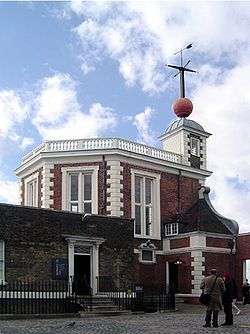
Although the use of time balls has been replaced by electronic time signals, some time balls have remained operational as historical tourist attractions.
History
The fall of a little ball was in antiquity a way to show to people the time. Ancient Greek clocks had this system in the main square of a city, as in the city of Gaza in post-Alexander era and till the 7th century AD as Procopius described in his book on Edifices. Time ball stations set their clocks according to transit observations of the positions of the sun and stars. Originally they either had to be stationed at the observatory, or had to keep a very accurate clock at the station which was set manually to observatory time. Following the introduction of the electric telegraph around 1850, time balls could be located at a distance from their source of mean time and operated remotely.
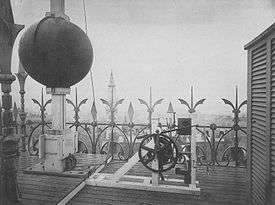
The first time ball was erected at Portsmouth, England, in 1829 by its inventor Robert Wauchope, a captain in the Royal Navy.[1] Others followed in the major ports of the United Kingdom (including Liverpool) and around the maritime world.[1] One was installed in 1833 at the Greenwich Observatory in London by the Astronomer Royal, John Pond, and the time ball has dropped at 1 p.m. every day since then.[2] Wauchope submitted his scheme to American and French ambassadors when they visited England.[1] The United States Naval Observatory was established in Washington, D.C., and the first American time ball went into service in 1845.[1]
Time balls were usually dropped at 1 p.m. (although in the United States they were dropped at noon). They were raised half way about 5 minutes earlier to alert the ships, then with 2–3 minutes to go they were raised the whole way. The time was recorded when the ball began descending, not when it reached the bottom.[2] With the commencement of radio time signals (in Britain from 1924), time balls gradually became obsolete and many were demolished in the 1920s.[3]
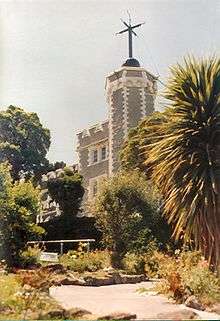
A contemporary version of the concept has been used since 31 December 1907 at New York City's Times Square as part of its New Year's Eve celebrations; at 11:59 p.m., a lit ball is lowered down a pole atop the One Times Square tower over the course of sixty seconds, concluding at midnight. For the arrival of 1988, the event's organizers acknowledged the addition of a leap second by extending the drop to 61 seconds (in reality, the leap second was applied worldwide five hours earlier at midnight UTC). The spectacle was inspired by an organizer having seen the time ball on the Western Union Building in operation.[5][6]
Around the world
Today there are over sixty time balls standing, though many of these are no longer operational. Existing time balls include the following:
Australia
- The Old Windmill, Brisbane, Queensland
- Fremantle, Western Australia
- Sydney Observatory, New South Wales
- Newcastle Customs House, New South Wales
- Semaphore, South Australia
- Williamstown Lighthouse, Victoria
Canada
New Zealand
- Lyttelton Timeball Station
- The Lyttelton Timeball Station in Lyttelton, New Zealand, was operational until it was damaged in the 2010 Canterbury earthquake. Further severe damage occurred in the February 2011 Christchurch earthquake,[7] and a decision was made in March 2011 to dismantle the building, a danger to the public,[8] but the tower collapsed during the major aftershock that hit the Lyttelton area on 13 June 2011.[9] In November 2012, a large financial donation [10] was made available to contribute towards rebuilding the tower, a project the community considered. On 25 May 2013, it was announced that the tower and ball would be restored, and that funds were to be sought from the community to rebuild the rest of the station. The station was officially reopened on 2 November 2018.[11][12]
- Wellington
- The Wellington time ball service started in March 1864.[13] It received its time information from the Dominion Observatory which was also communicated to the Lyttelton time ball service.[14] Dunedin used local observatory facilities.[13]
- Wellington had two time ball sites – the time ball was erected at the first site by mid-January 1864 on top of the Custom House building on the Wellington waterfront [15] and later relocated in 1888 to the J Shed Woolstore on top of the accumulator tower.[13] This building and the time ball burnt down on 9 March 1909.[16]
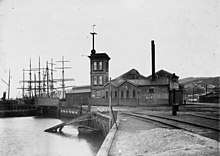
- Instead of replacing the Wellington time ball after the second site burnt down, time light signals were introduced at the Dominion Observatory. The earliest record of this was 22 February 1912.[17] They were in use until 1937 when wireless signals took over as the new way to keep time.[14]

Poland
South Africa
United Kingdom
- Deal, Kent, England
- Margate Clock Tower, Kent, England
- Royal Observatory, Greenwich, England
- Time Ball Buildings, Leeds, England
- Guildhall, Kingston upon Hull, England. The only maritime timepiece on a municipal building. It dates back to 1918 and is the highest in the UK.[18]
- Clock Tower, Brighton, East Sussex, England. (originally operated hourly, but was later stopped as it was too noisy)[19]
- Nelson's Monument on Calton Hill, Edinburgh, Scotland
United States
- United States Naval Observatory, Washington D.C.
- Titanic Memorial, New York City
- Plymouth Light, Gurnet Point, Plymouth, Massachusetts
Gallery

.jpg)
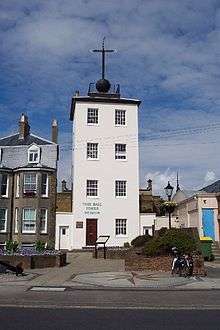 Deal Timeball, Deal, UK
Deal Timeball, Deal, UK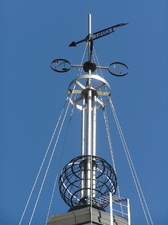 Gdańsk, Poland
Gdańsk, Poland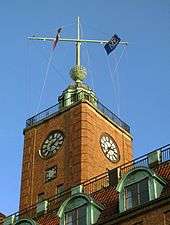 Gothenburg, Sweden
Gothenburg, Sweden
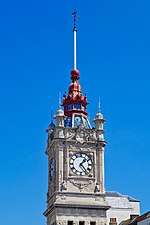 Clock tower, Margate, Kent, UK
Clock tower, Margate, Kent, UK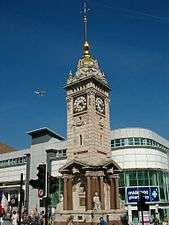 Clock tower, Brighton, UK
Clock tower, Brighton, UK Time Ball, Cape Town, South Africa
Time Ball, Cape Town, South Africa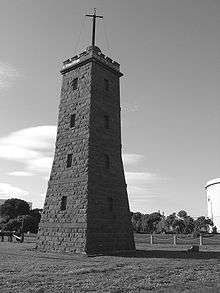
See also
- Blackhead Point, in Hong Kong, where a time ball was operated from 1908 to 1933
- History of longitude
- Shepherd Gate Clock
- Time signal
- Weather ball
- Greenwich Mean Time (GMT)
References
- Aubin, David (2010). The Heavens on Earth: Observatories and Astronomy in Nineteenth-Century Science and Culture. Durham, N.C.: Duke University Press. p. 164. ISBN 978-0-8223-4640-1.
- "Time ball". Greenwich2000. Greenwich Mean Time. 2019. Retrieved 12 December 2019.
- "The Gdańsk Nowy Port Lighthouse and Time Ball". Archived from the original on 13 February 2012. Retrieved 4 January 2009.
- "Lyttelton Timeball Station, Christchurch". Yahoo! Travel.
- McFadden, Robert D. (31 December 1987). "'88 Countdown: 3, 2, 1, Leap Second, 0". The New York Times. Retrieved 2 January 2009.
- "NYC ball drop goes 'green' on 100th anniversary". CNN. 31 December 2007. Retrieved 31 December 2007.
- "New Zealand quake: The epicentre town". BBC News. 25 February 2011.
- Gates, Charlie (4 March 2010). "Timeball Station to be demolished". stuff.co.nz. Retrieved 15 June 2011.
- Greenhill, Marc (14 June 2011). "Workmen unscathed as Timeball Station collapses". stuff.co.nz. Archived from the original on 24 October 2012. Retrieved 15 June 2011.
- Greenhill, Marc (28 November 2012). "Donor fronts to save Lyttelton Timeball Station". Stuff. stuff.co.nz. Retrieved 28 November 2012.
- Lee, Francesca (25 May 2013). "Million dollar donation to rebuild Lyttelton Timeball". Stuff. stuff.co.nz. Retrieved 25 May 2013.
- "$1m donation to rebuild timeball". Radio New Zealand. radionz.co.nz. 25 May 2013. Retrieved 25 May 2013.
- Kinns, Roger (2017). "The Principal Time Balls of New Zealand". Journal of Astronomical History and Heritage. 20 (1): 69–94.
- Kinns, Roger (2017). "The Time Light Signals of New Zealand: Yet Another Way of Communicating Time in the Pre-Wireless Area". Journal of Astronomical History and Heritage. 20 (2): 211–222.
- "Wellington (from our own correspondent)". Nelson Examiner and New Zealand Chronicle. 11 January 1864. Retrieved 20 December 2018.
- "A Big Blaze". The Dominion. 10 March 1909. Retrieved 19 December 2018.
- "Ships and Shipping". New Zealand Times. 22 February 1912. Retrieved 19 December 2018.
- "Hull Guildhall's Time Ball set to rise and fall once again". BBC News. BBC. Retrieved 19 October 2018.
The ball is one of just a few nationally and is the only maritime timepiece on a municipal building. It dates back to 1918 and is the highest in the UK.
- "Heritage Gateway Listed Buildings Online — Clock Tower and Attached Railings, North Street (north side), Brighton, Brighton and Hove, East Sussex". Heritage Gateway website. Heritage Gateway (English Heritage, Institute of Historic Building Conservation and ALGAO:England). 2006. Retrieved 2 June 2010.
External links
| Wikimedia Commons has media related to Time balls. |
- "List of Timeballs". Index to the House Documents, Otherwise Publ. as Executive Documents. U.S. Congress. 1876–1877. pp. 305–308. List of time balls worldwide in 1876.
- Time ball/cannon hobbyist
- Time ball and cannon Association